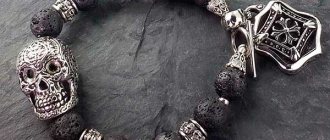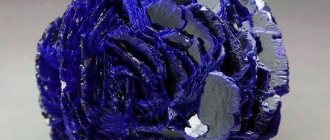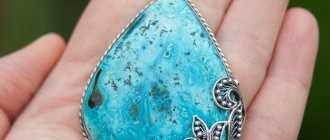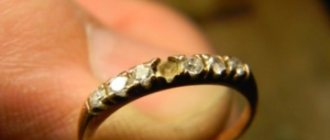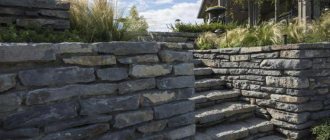This term has other meanings, see Lava (meanings).
Lava
(Italian lava - fall) - a hot liquid (effusion) or very viscous (extrusion) melt of rocks, predominantly silicate composition (SiO2 from about 40 to 95%), pouring onto the surface of the Earth during volcanic eruptions. Magma, coming to the surface, becomes lava and is freed from gases[1]. The speed of the lava flow can reach several meters per second. The lava temperature ranges from 500[2] to 1200° C.
When lava hardens, various effusive rocks are formed. Solidified lava takes many forms and can form a lava plateau, lava lake, or other lava sheets.
Lava formation
Lava is formed when a volcano releases magma onto the Earth's surface. Due to cooling and interaction with gases that make up the atmosphere, magma changes its properties, forming lava. Many volcanic island arcs are associated with deep fault systems. The centers of earthquakes are located approximately at a depth of up to 700 km from the earth's surface, that is, the volcanic material comes from the upper mantle. On island arcs it often has an andesitic composition, and since andesites are similar in composition to the continental crust, many geologists believe that the continental crust in these areas builds up due to the influx of mantle material.
Volcanoes that operate along oceanic ridges (such as the Hawaiian Ridge) erupt predominantly basaltic material, such as aa lava. These volcanoes are probably associated with shallow earthquakes, the depth of which does not exceed 70 km. Because basaltic lavas are found both on continents and along ocean ridges, geologists hypothesize that there is a layer just below the Earth's crust from which basaltic lavas come.
However, it is unclear why in some areas both andesites and basalts are formed from mantle material, while in others only basalts are formed. If, as is now believed, the mantle is indeed ultramafic (enriched in iron and magnesium), then lavas derived from the mantle should have a basaltic rather than andesitic composition, since andesites are absent in ultramafic rocks. This contradiction is resolved by the theory of plate tectonics, according to which the oceanic crust moves under island arcs and melts at a certain depth. These molten rocks erupt in the form of andesite lavas.
Healing and magical properties of lava stone
The close relationship with the earth gives the stone the ability to help those who need peace and renewal of life. He heals not only the physical body, but also the mental state. The forces of nature provide energy balance.
The healing properties of lava stone stabilize the nervous and circulatory systems, and also have a beneficial effect on the psyche. Owners of the gem live in harmony with their inner “I”, they feel better about the body and its needs. Easier to bear loads.
According to Indian philosophy, lava stone affects the first chakra, increasing life potential and strengthening character. If you touch the desired energy point with it, you can feel warmth and peace, and the energy of other amulets will only intensify.
Volcanic lava combines the forces of four elements. Jewelry made from it becomes strong amulets that preserve energy and a positive attitude. The owner miraculously gains the strength to achieve his goals; the mineral supports him in everything.
Lava stone is an excellent home amulet; it does not allow unwanted guests into the apartment and protects against any negativity aimed at the family. In a house where there is a lava figurine, peace, harmony and prosperity reign.
The gem gives its owner the ability to distinguish signs of fate and unravel messages in prophetic dreams. A person is better aware of what he wants and what he dreams of. He shows hidden talents for creativity or craft.
Even the wildest dreams come true thanks to lava, because it gives confidence in one’s own abilities and makes the right adjustments to the path of life.
Despite its volcanic origin, lava stone is suitable not only for representatives of the fire element. This is a universal amulet that helps almost all zodiac signs. It fully reveals its powers when given to Capricorns or Scorpios. He brings prosperity and success to their lives.
Lava is perfect for businessmen and people who have their own business. It enhances motivation and helps achieve goals with minimal effort.
Types of lava
Lava varies from volcano to volcano. It differs in composition, color, temperature, impurities, etc.
By composition
Basaltic lava
The main type of lava erupted from the mantle is characteristic of oceanic shield volcanoes. Half consists of silicon dioxide, half - from oxides of aluminum, iron, magnesium and other metals. This lava is very mobile and can flow at a speed of 2 m/s. It has a high temperature (1200-1300 °C). Basaltic lava flows are characterized by a small thickness (meters) and a large extent (tens of kilometers). The color of hot lava is yellow or yellow-red.
Carbonate lava
Half consists of sodium and potassium carbonates. This is the coldest and most liquid lava, it spreads like water. The temperature of carbonate lava is only 510–600 °C. The color of hot lava is black or dark brown, but as it cools it becomes lighter, and after a few months it becomes almost white. Solidified carbonate lavas are soft and brittle and easily dissolve in water. Carbonate lava flows only from the Oldoinyo Lengai volcano in Tanzania.
Silicon lava
Most characteristic of the volcanoes of the Pacific Ring of Fire. It is usually very viscous and sometimes freezes in the crater of a volcano even before the end of the eruption, thereby stopping it. A plugged volcano may swell somewhat, and then the eruption resumes, usually with a powerful explosion. The average flow rate of such lava is several meters per day, and the temperature is 800-900 °C. It contains 53-62% silicon dioxide (silica). If its content reaches 65%, then the lava becomes very viscous and slow. The color of hot lava is dark or black-red. Solidified silicon lavas can form black volcanic glass. Such glass is obtained when the melt cools quickly without having time to crystallize.
By shape
- Aa-lava is clastic or slag-block lava.
- Pahoehoe lava (var.: pahoehoe lava) is a smooth, wavy lava.
- Pillow lava is underwater lava solidified in the form of pillow-shaped bodies.
Links
- Metamorphoses of lava on the website of the magazine “Around the World”
Wikimedia Foundation.
2010. Synonyms
:
See what “Lava” is in other dictionaries:
- Lavash, ah, eat... Russian word stress
Dahl's Explanatory Dictionary
Women a different mixture of molten rocks flowing from the mouth of the fire mountains; floater II. LAVA female a bench, a blank, fixed bench, a board for a seat along the wall; sometimes a bench, a portable board with legs; | southern, novg., yarosl... ... Dahl's Explanatory Dictionary
- (Spanish lava flowing rain stream). Molten material erupted by volcanoes. Dictionary of foreign words included in the Russian language. Chudinov A.N., 1910. LAVA is a substance ejected from a vent by a volcano. Complete dictionary of foreign words... Dictionary of foreign words of the Russian language
Production, mass, face, reach, structure, attack, magma Dictionary of Russian synonyms. lava noun, number of synonyms: 20 aa lava (2) at ... Dictionary of synonyms
LAVA, molten rock, or MAGMA, reaching the surface of the Earth and flowing through volcanic vents in streams or sheets. There are three main types of lava: bubbly, like pumice; glassy, like obsidian; Equal-grained. By... ... Scientific and technical encyclopedic dictionary
1. LAVA1, lava, female. (Italian lava). 1. Molten fiery liquid mass ejected by a volcano during an eruption. 2. transfer Something grandiose, fast, steadily moving, sweeping away everything along the way. “We are marching on a revolutionary path.” Mayakovsky ... Ushakov's Explanatory Dictionary
Lava that appears after a volcanic eruption, when it gets into the water, turns into porous stone. The majority of its chemical composition is carbonate, silicon or basalt. Depending on the predominant substance, minerals differ in color, structure and density.
Lava stone is mined in Iceland, South America and many islands where there are active volcanoes. On the territory of Russia it can be found in the Kamchatka region. Even ancient tribes actively used black pieces for magical rituals.
It is believed that the talisman has absorbed the energy of the earth. It brings stability to life and gives peace. Volcanic lava is popular among figurines, homewares, and jewelry makers, but is not considered a precious material.
Lava stone contains a mixture of different rocks, so it is easy to detect almost all known chemicals in its composition. The mineral can be of several colors: white, gray, pink, blue or black. But its surface will always have many irregularities and pores.
Solidified lava perfectly retains heat for a long time; this feature was inherited from the Fire element. Outwardly, the material seems quite brittle, but this is not so - it has a huge margin of strength like the Earth.
The stone is not at all afraid of Water; rather, on the contrary, it uses it to cleanse itself of accumulated negativity. The air element also endowed it with its own qualities, namely free spirit and independence, which are also transmitted to the owners. Thus, the stone has the properties of all four elements.
Excerpt characterizing Love
The next day, Prince Andrei remembered yesterday's ball, but did not dwell on it for long. “Yes, it was a very brilliant ball. And also... yes, Rostova is very nice. There is something fresh, special, not St. Petersburg, that distinguishes her.” That's all he thought about yesterday's ball, and after drinking tea, he sat down to work. But from fatigue or insomnia (the day was not a good one for studying, and Prince Andrei could not do anything), he kept criticizing his own work, as often happened to him, and was glad when he heard that someone had arrived. The visitor was Bitsky, who served on various commissions, visited all the societies of St. Petersburg, a passionate admirer of new ideas and Speransky and a concerned messenger of St. Petersburg, one of those people who choose a direction like a dress - according to fashion, but who for this reason seem to be the most ardent partisans of directions . He worriedly, barely having time to take off his hat, ran to Prince Andrei and immediately began to speak. He had just learned the details of the meeting of the State Council this morning, opened by the sovereign, and was talking about it with delight. The sovereign's speech was extraordinary. It was one of those speeches that are given only by constitutional monarchs. “The Emperor directly said that the council and the senate are state estates; he said that government should not be based on arbitrariness, but on solid principles. The Emperor said that finances should be transformed and reports should be made public,” said Bitsky, emphasizing well-known words and significantly opening his eyes. “Yes, the current event is an era, the greatest era in our history,” he concluded. Prince Andrei listened to the story about the opening of the State Council, which he expected with such impatience and to which he attributed such importance, and was surprised that this event, now that it had happened, not only did not touch him, but seemed to him more than insignificant. He listened to Bitsky's enthusiastic story with quiet mockery. The simplest thought came to his mind: “What does it matter to me and Bitsky, what do we care about what the sovereign was pleased to say in council! Can all this make me happier and better?” And this simple reasoning suddenly destroyed for Prince Andrei all the previous interest in the transformations being carried out. On the same day, Prince Andrei was supposed to dine at Speransky’s “en petit comite,” [in a small meeting], as the owner told him, inviting him. This dinner in the family and friendly circle of a man whom he admired so much had previously greatly interested Prince Andrei, especially since until now he had not seen Speransky in his home life; but now he didn’t want to go. At the appointed hour of lunch, however, Prince Andrei was already entering Speransky’s own small house near the Tauride Garden. In the parquet dining room of a small house, distinguished by its extraordinary cleanliness (reminiscent of monastic purity), Prince Andrei, who was somewhat late, already found at five o’clock the entire company of this petit comite, Speransky’s intimate acquaintances, gathered. There were no ladies except Speransky's little daughter (with a long face similar to her father) and her governess. The guests were Gervais, Magnitsky and Stolypin. From the hallway, Prince Andrei heard loud voices and clear, clear laughter - laughter similar to the one they laugh on stage. Someone in a voice similar to Speransky’s voice distinctly chimed: ha... ha... ha... Prince Andrei had never heard Speransky’s laughter, and this ringing, subtle laughter of a statesman strangely struck him. Prince Andrei entered the dining room. The whole company stood between two windows at a small table with snacks. Speransky, in a gray tailcoat with a star, obviously still wearing the white vest and high white tie he wore at the famous meeting of the State Council, stood at the table with a cheerful face. Guests surrounded him. Magnitsky, addressing Mikhail Mikhailovich, told an anecdote. Speransky listened, laughing ahead at what Magnitsky would say. As Prince Andrei entered the room, Magnitsky’s words were again drowned out by laughter. Stolypin boomed loudly, chewing a piece of bread with cheese; Gervais hissed with a quiet laugh, and Speransky laughed subtly, distinctly. Speransky, still laughing, gave Prince Andrei his white, tender hand. “I’m very glad to see you, prince,” he said. - Just a minute... he turned to Magnitsky, interrupting his story. “We have an agreement today: dinner of pleasure, and not a word about business.” - And he turned to the narrator again, and laughed again. Prince Andrei listened to his laughter with surprise and sadness of disappointment and looked at the laughing Speransky. It was not Speransky, but another person, it seemed to Prince Andrei. Everything that had previously seemed mysterious and attractive to Prince Andrei in Speransky suddenly became clear and unattractive to him. At the table the conversation did not stop for a moment and seemed to consist of a collection of funny anecdotes. Magnitsky had not yet finished his story when someone else declared his readiness to tell something that was even funnier. The anecdotes mostly concerned, if not the official world itself, then the official persons. It seemed that in this society the insignificance of these persons was so finally decided that the only attitude towards them could only be good-naturedly comic. Speransky told how at the council this morning, when asked by a deaf dignitary about his opinion, this dignitary answered that he was of the same opinion. Gervais told a whole story about the audit, remarkable for the nonsense of all the characters. Stolypin stutteringly intervened in the conversation and began to speak passionately about the abuses of the previous order of things, threatening to turn the conversation into a serious one. Magnitsky began to mock Stolypin’s ardor, Gervais inserted a joke and the conversation again took its previous, cheerful direction. Obviously, after work, Speransky loved to relax and have fun in a circle of friends, and all his guests, understanding his desire, tried to amuse him and have fun themselves. But this fun seemed heavy and sad to Prince Andrei. The thin sound of Speransky’s voice struck him unpleasantly, and the incessant laughter, with its false note, for some reason offended the feelings of Prince Andrei. Prince Andrei did not laugh and was afraid that he would be difficult for this society. But no one noticed his inconsistency with the general mood. Everyone seemed to be having a lot of fun.
Jewelry and decorative material
The exotic petrified magma of volcanoes is loved by jewelers, stone cutters, and decorators.
Jewelry sphere
The stone or jewelry made from it (bracelets, beads, pendants, rosaries) are classified as costume jewelry.
Lava Bracelet
The non-trivial surroundings made the mineral a hit in the jewelry industry:
- suitable for ladies and men;
- the products look stylish, but discreet, so they are appropriate for any wardrobe or event;
- combines with semi- or opaque stones of all colors (agate, coral, garnet, turquoise).
A frame made of precious metals makes the accessory precious. Such products are made to order. The best examples (especially from black lava) look like they could replace top-tier gems in evening wear.
Decor
A wide range of decor is created from stone: wall mosaics, countertops, tiles, small plastic. Obsidian knives or figurines are a collectible. Stone from volcanic lava is an elite material for cladding, expensive designer furniture.
Price
The price of accessories made of lava stone without a precious frame is measured in hundreds of rubles (cost, rub.):
- bracelet (lava, agate, garnet) – 350;
- bracelet Shambhala (lava) – 260;
- beads (lava, agate) – 650.
Availability and low price are an almost one hundred percent guarantee of the authenticity of lava stone. It is unprofitable to fake it.




